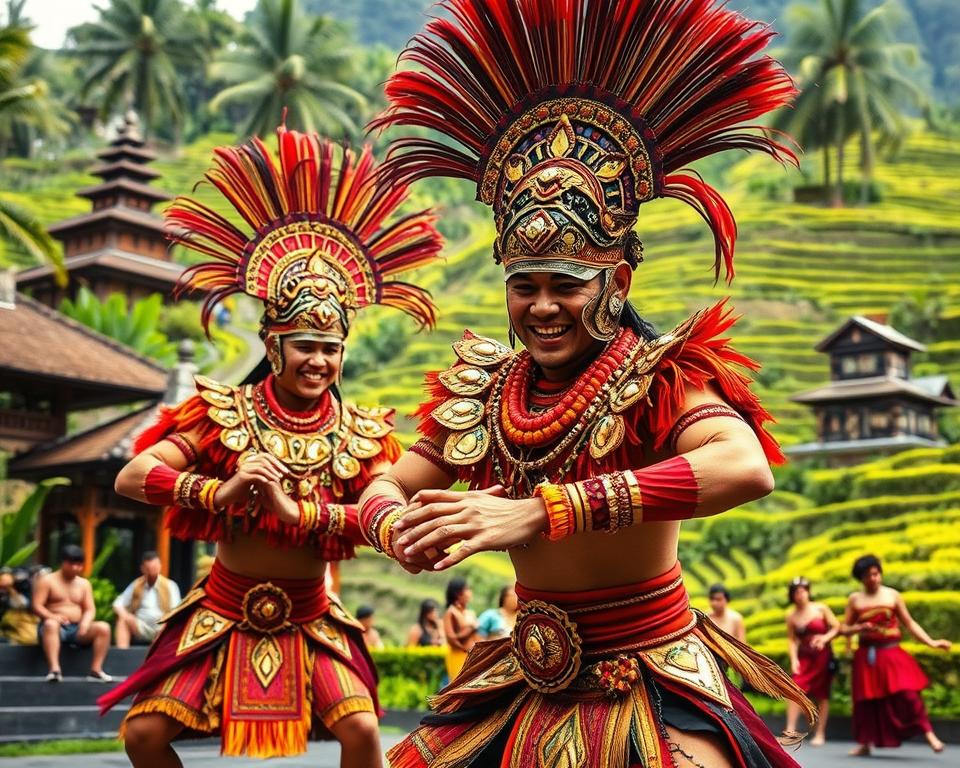
Discover Baris Dance: Bali’s Ancient Warrior Ritual
Did you know traditional Balinese dances are divided into three types? Wali (sacred dances), Bebali (semi-sacred dances), and Balih-Balihan (entertainment dances). Each dance has its own purpose and audience1. Baris Dance is a special one, showing Bali’s history and the bravery of ancient warriors.
It’s performed at big temple ceremonies like Galungan and Kuningan. Male dancers, from 8 to 40, show their skills, acting like warriors ready for battle1
The dance is full of detailed steps and bright costumes. It shows the rich culture of Bali, more than just a show. Every step and beat carries the spirit of Bali, drawing viewers into a centuries-old ritual.
Seeing Baris Dance is like stepping back in time. It honours the past and keeps Bali’s heritage alive. It connects old traditions with today’s celebrations.
Key Takeaways
- Baris Dance is an ancient Balinese warrior ritual that emphasises valour and devotion.
- This dance is traditionally performed during important temple feasts and ceremonies.
- Baris performances typically involve a group of well-trained male dancers.
- It serves as a vibrant expression of Balinese cultural identity.
- The dance features intricat choreography, rich costumes, and live music, immersing audiences in its historical context.
- Baris Dance is part of a broader classification of traditional Balinese dances.
- Key events for Baris performances include Galungan and Kuningan.
Introduction to Balinese Cultural Dance
Step into the enchanting world of Balinese Cultural Dance. Every movement is a gateway to Bali’s spiritual essence. You see the sacred art deeply rooted in the island’s rich tapestry. Dance is not just a performance; it’s a way to express the divine2.
UNESCO has recognised it as an Intangible Cultural Heritage. Three genres of traditional dance show the island’s vibrancy. They are made up of nine distinct forms3.
Dancers start their training as young as seven. They show great skill and poise. Their eye and facial expressions tell stories filled with cultural significance2.
The hand motions, called Mudras, have deep spiritual meaning. They guide the audience on a journey of intent and connection with the divine2.
During sacred rituals, these performances take place in temples. They follow strict protocols. This makes the dance more than just watching; it’s an experience that connects everyone2.
Whether it’s the vibrant Baris Dance or the delicate Legong, each part tells a part of Bali’s story. It’s a tale of spirituality and culture.
The Origins of Baris Dance
In Bali’s heart, the Baris Dance shows the island’s ancient warrior traditions. It comes from ‘beberisan’, ancient soldiers’ formations. These show military order and strength.
The Balinese Warrior Dance is celebrated at big cultural and religious events. Old texts and stories tell how Baris evolved over time. Today, over thirty types of Baris dance are performed, each special to its area45.
Men in groups of eight to forty perform Baris Dance at big events. They show warrior life through playfighting, called masesraman. Some dances, like Baris Dadap, with dancers and shields, are less common now45.
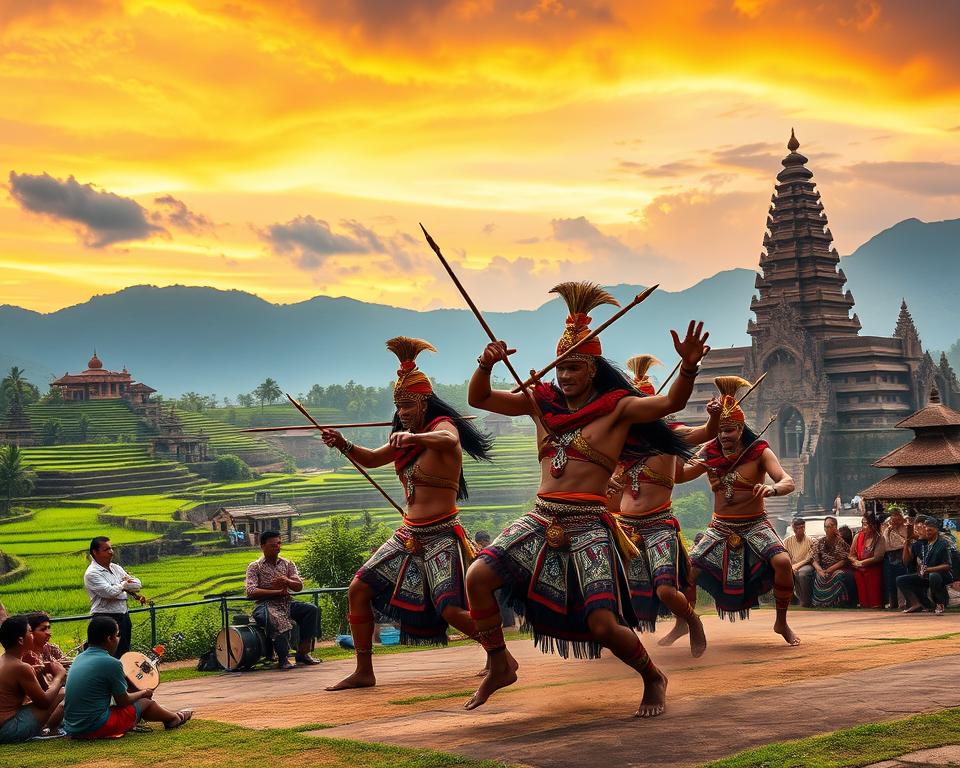
The mix of history and art keeps the Baris Dance alive. It keeps the spirit of the warriors alive in our hearts, across generations.
Understanding Baris Dance Rituals
The Baris Dance shows the deep culture of Bali. It’s not just dance; it’s a spiritual act. Male dancers, from eight to forty, show bravery and devotion in their moves65. This dance connects people to the divine, using Bali’s sacred energy.
Baris Dance is key at big events like temple anniversaries and cremations. It’s timed with the full moon6. Dancers wear colourful costumes, telling stories of heritage and pride6.
The dance is deeply spiritual, seeking blessings before starting. The Gamelan Gong adds to the experience, filling the air with sound6. Baris dances, like Baris Melambahan, tell stories from the Ramayana, linking culture, myth, and memory67.
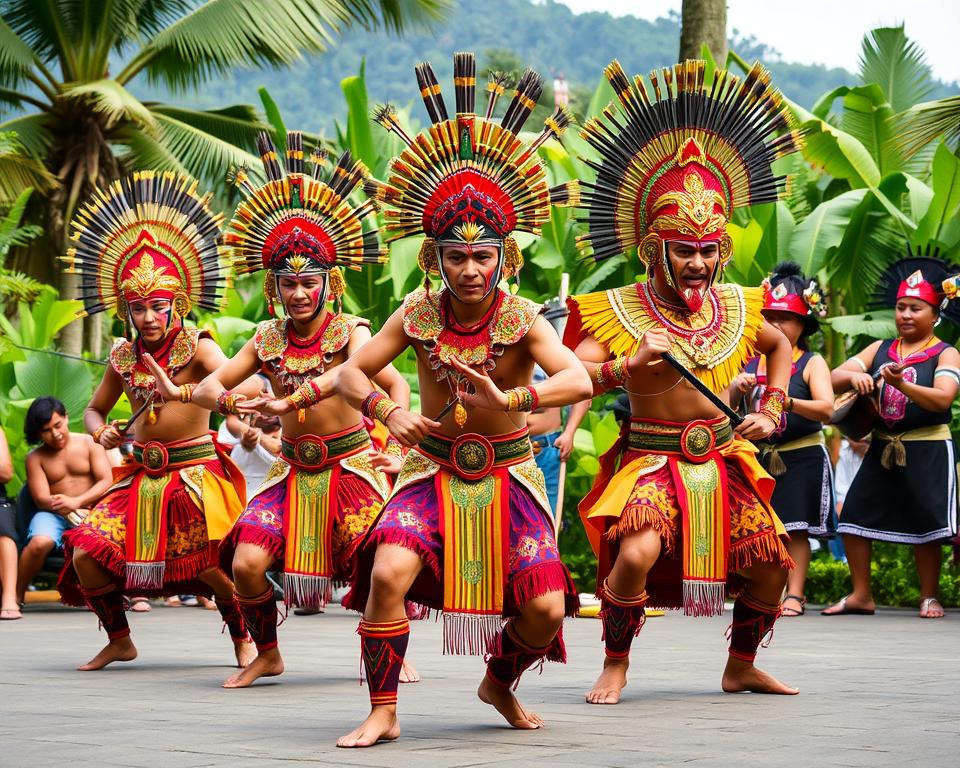
Baris Dance: A Glimpse into Balinese Warrior Culture
When you see the Baris Dance, you meet art and history. It shows the Balinese Warrior Culture in a special way. This dance tells stories of bravery, linking the past to today.
It invites you into a world where history and culture meet. This happens through the dance’s rhythm.
The Role of Warriors in Baris Performances
Baris Dance is all about the brave warriors who protected Bali. You see their spirit in every move. It shows their strength and dedication.
This dance is a tribute to these heroes. It keeps their stories alive through the dance’s rhythm.
The Historical Significance of Baris Dance
The Baris Dance History goes back to the 14th century. It’s a key part of Bali’s culture and tradition. It helps keep Bali’s heritage alive.
But, there’s a worry. Young people might not learn these dances anymore. This could lead to a loss of tradition.
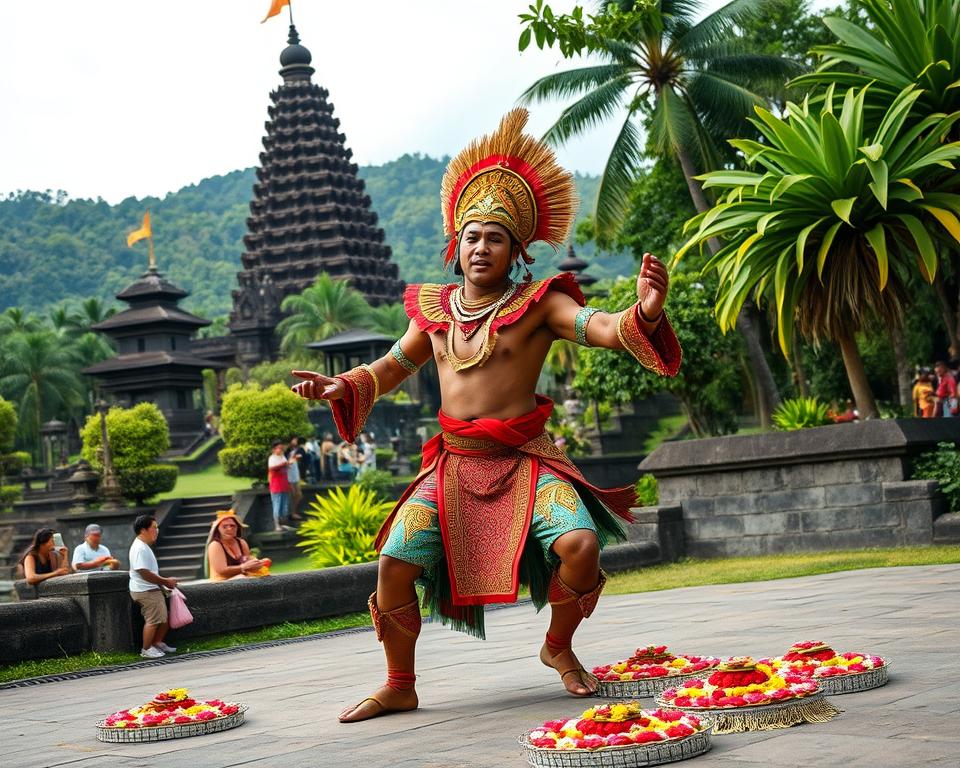
| Aspect | Description |
|---|---|
| Dance Type | Solo performance dedicated to warriors |
| Historical Roots | Originating from local traditions as far back as the 14th century |
| Training | Rigorously conducted to embody warrior characteristics |
| Cultural Role | Preserving stories and cultural heritage of Bali |
This dance shows the bravery of Bali’s warriors. It reminds us of their spirit through the dance’s lively movements8.
The Unique Characteristics of Baris Costume
As you dive into the world of Baris dance, the Baris Costume grabs your eye. Each part has a special meaning, showing beauty and cultural importance. The traditional Balinese Attire is like a story, full of history and identity.
Elements of the Traditional Baris Costume
The Baris Costume has unique parts that make it stand out. You’ll see:
- Gelungan: An ornate headpiece that adds height and grace.
- Awirans: Colourful scarves that dancers wear, adding movement to the dance.
- Shirts: With bold colours like red, black, and white, each has its own meaning.
- Bapang: A ceremonial neckband that shows bravery and strength.
- Keris: A traditional dagger that shows courage in the dance.
The Symbolism Behind Baris Dance Attire
The Baris Costume parts tell deep stories and connect to Balinese culture. Each piece reflects a journey filled with tradition, celebrating the dance’s history. It’s a mix of ancient and modern, showing the beauty of Traditional Balinese Attire.
These costumes show the mix of art and culture, showing the Balinese people’s identity. They honour their past and look forward to the future910.
Baris Dance Choreography and Performance Styles
Baris Dance Choreography shows the heart of Bali’s warrior culture. It mixes martial arts with beautiful movements. Each show tells a story, with dancers showing the spirit of their ancestors11.
This amazing show has 30 different types of Baris Dance. Each one has its own story and look11.
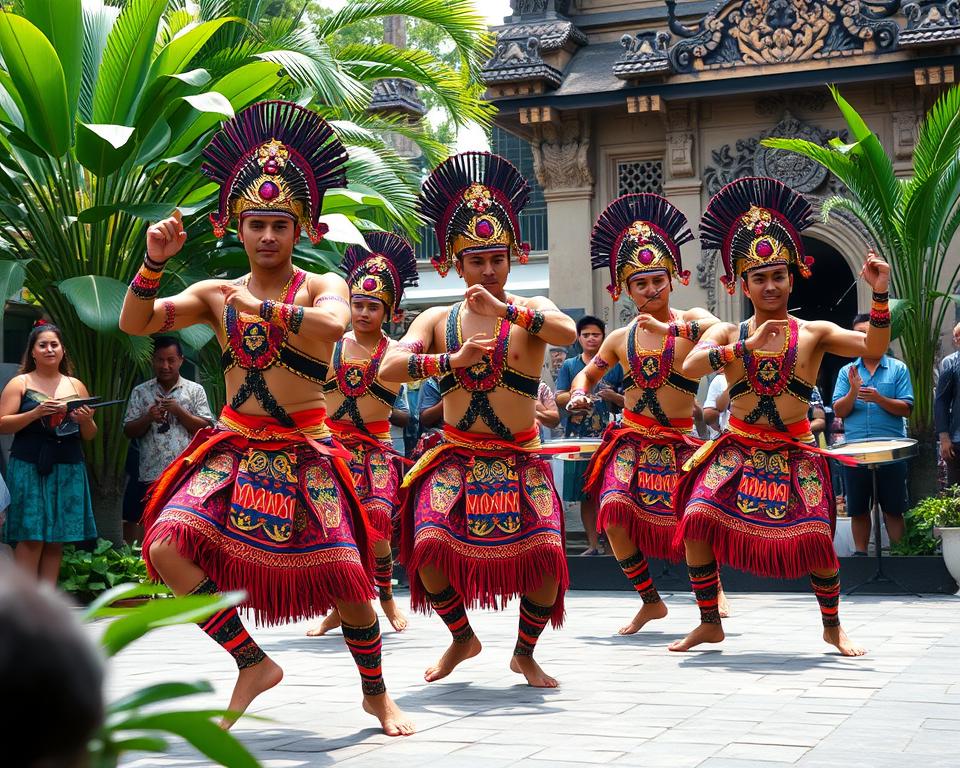
The Baris Kraras Dance is a solo dance for special ceremonies. It’s seen at the Aci Tulak Tunggul, held every Tuesday Kliwon at Taman Ayun Temple11. It shows the beauty of Baris Dance, keeping Balinese culture alive. It’s important for the eleven Banjars of Mengwi Village11.
- Structured sequences: Dancers follow precise steps, like traditional warrior drills.
- Thematic performances: Each dance tells a different story, from battles to stories, showing warrior strength.
- Improvisation and style: Some dances, like Baris Tunggal, add improvisation, making the dance rich12.
The choreography is set to enchanting rhythms and music. This makes the Balinese Dance Performance even more special. Kidung songs add to the story and culture of the show11. Each style celebrates the unique parts of Balinese heritage, making the community’s identity richer.
The Music and Instruments of Baris Dance
The heart of Baris Dance is its music. It’s filled with the sounds of Balinese Instruments. The Gambelan Gong is at the centre, making the dance even more special.
This orchestra has metallophones, gongs, and flutes. It creates a rich sound that grabs everyone’s attention. The rhythm and depth of the music are truly captivating.
The Role of Gambelan Gong in Baris Performances
The Gambelan Gong is key in Baris performances. It connects dancers to a long history, going back to the 8th Century BC. The music brings a powerful atmosphere to the dance.
The Gamelan music is special, using a unique scale. This scale shows the dancers’ skill with every beat13.
Instrumentation in Baris Dance Music
Baris Music has many instruments, each adding its own sound. You’ll find:
- Gong
- Kempur
- Kemong
- Kempli
- Jegogan
- Calung
- Ugal
- Gangsa (Pemade and Kantilan)
- Reyong
- Kendhang
- Ceng-ceng
- Suling
The music of Baris Melampahan is full of different sounds. It’s a mix of loud and soft, showing the dance’s emotional depth. The Jegogan and a core melody called pokok add to the feeling13.
Together, these instruments make Baris come alive. The music stays with you long after the show ends.
Different Types of Baris Dance
Baris Dance is a rich mix of forms, each with its own story and importance. Baris Tumbak is the spear dance, known for its lively moves that show off the dancers’ skill. It’s a visual treat that honors Bali’s martial traditions.
Baris Tumbak: The Spear Dance
Baris Tumbak takes you back to the days of warriors. Dancers with spears show off their bravery and skill. Their energetic moves tell a story of strength and agility, linking Bali’s past to today.
Baris Melambahan: A Dance Drama
Baris Melambahan is a dance drama that tells stories from the Ramayana and Mahabharata. It mixes dance and theater, giving you a deep dive into Bali’s spiritual and historical tales. Each show is a celebration of Balinese culture and beliefs.
Variations and Their Cultural Contexts
Baris Dance has many variations, each showing a different side of Bali’s culture. These dances offer a peek into Bali’s rich history. They are more than just shows; they teach us about Bali’s history and beliefs, touching the hearts of its people141516.
FAQ
What is Baris Dance?
Baris Dance is an ancient Balinese warrior ritual. It shows Balinese cultural identity through dance, costumes, and music. It talks about bravery and devotion.
What are the traditional occasions for performing Baris Dance?
It’s performed at important ceremonies and temple feasts. Galungan and Kuningan are key events. Places like Pura Besakih and Pura Batur are significant.
How does Baris Dance reflect Balinese cultural history?
The dance tells a spiritual journey. It shows the bravery of ancient Balinese soldiers. It keeps the community’s history and values alive through stories and performances.
What elements make up the costume worn in Baris Dance?
The costume has a decorated headpiece called gelungan. It also has colourful scarves, a bapang neckband, and a keris dagger. These symbols show bravery and cultural importance.
What type of music is used during Baris Dance performances?
The Gambelan Gong orchestra plays during performances. It uses instruments like metallophones, gongs, flutes, and drums. This music adds drama and emotion to the dance.
What variations of Baris Dance exist?
There are different types of Baris Dance. Baris Tumbak is the spear dance. Baris Melambahan tells stories from the Ramayana and Mahabharata.
How does Baris Dance contribute to the spiritual life of the Balinese people?
Baris Dance shows the connection to the divine. It’s a way to honour the gods and show cultural pride. It’s deeply rooted in spiritual beliefs.
What skills are showcased through Baris Dance performances?
The dance combines martial arts and dance. It shows strength, grace, and discipline. It portrays the skill of ancient warriors.
Source Links
- Balinese dance – Your Bali Travel Guide – https://yourbalitravelguide.com/info/culture/traditional-dance/
- Balinese Dance: The Spiritual Language of the Island – https://warriorsdivine.com/blogs/the-path/balinese-dance-the-spiritual-language-of-the-island
- Balinese dance – https://en.wikipedia.org/wiki/Balinese_dance
- Baris dance – https://en.wikipedia.org/wiki/Baris_dance
- Baris Dance | A traditional war dance and a sacred dance – https://www.seeingbali.com/article/?art=baris_dance
- Baris Dance – https://baliskytour.wordpress.com/bali-dances/baris-dance/
- Baris Keraras Dance: Symbolism in the Aci Tulak Tunggul Ritual of Mengwi Village – https://budayabali.com/baris-keraras-dance-symbolism-in-the-aci-tulak-tunggul-ritual-of-mengwi-village
- A Glimpse at Balinese Dance – https://ridwanbahasa.wordpress.com/2013/04/25/a-glimpse-at-balinese-dance/
- DBPIA-NURIMEDIA – https://kjournal.co.kr/xml/11092/11092.pdf
- PDF – http://repo.isi-dps.ac.id/2939/1/3_The Meaning of Baris Kraras.pdf
- PDF – https://www.ijhssnet.com/journals/Vol_8_No_5_May_2018/12.pdf
- A Baris Tunggal Dance Performance at Ubud Royal Palace, Bali. – http://gustavothomastheatre.blogspot.com/2010/04/baris-tunggal-dance-performance-at-ubud.html
- Microsoft Word – 59. Gong Kebyar de Sebatu _Bali_ – Baris Melampahan.doc – https://qualifications.pearson.com/content/dam/pdf/A Level/Music/2013/Unit-6-59-Gong-Kebyar-de-Sebatu-Bali.pdf
- Balinese Dance – Palm Living – https://palm-living.com/balinese-dance/
- Balinese Dance: History, Types, and Where to See It – Ubud Villas Rental – https://www.ubudvillasrental.com/balinese-dance-history-and-values-behind-its-beauty/
- Visitbali – Baris Jangkang Dance, A Sacred Dance Which Becomes Indonesian Cultural Heritage – https://visitbali.id/property/baris-jangkang-dance-a-sacred-dance-which-becomes-indonesian-cultural-heritage